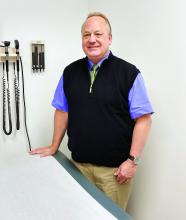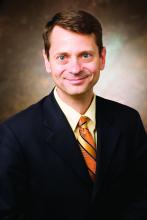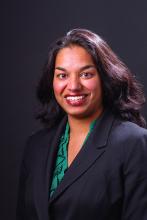The grip that opioid addiction has on adolescents often resembles that on addicted adults. Both groups crave the next high at all costs.
“Basically, they’re living to find their next heroin or opioids because their ‘feeling good’ completely depends on it,” Steven C. Matson, MD, , chief of the division of adolescent medicine at Nationwide Children’s Hospital, Columbus, Ohio, said in an interview. “They’re up in the morning, out trying to hustle money constantly, and then using and rebounding, and doing it over and over again. It gets to be a pretty dismal way of life.”
After losing several friends to opioid overdoses, a 17-year-old patient of Leslie Hulvershorn, MD, became so emotionally hardened that she thought little of her own young life. “She suffers from depression and PTSD and has talked from time to time about how she doesn’t really care if she lives or dies,” said Dr. Hulvershorn, a child and adolescent psychiatrist who runs an adolescent addiction treatment outpatient program at Riley Hospital for Children, Indianapolis.Parents often have no clue that their child is addicted to opioids, whether prescription forms like oxycodone or synthetic forms like heroin. “It usually only becomes clear when it comes to the attention of a probation officer or a school that insists on treatment,” said Dr. Hulvershorn, who is also medical director for the State of Indiana’s Division of Mental Health and Addiction, which licenses and certifies all of the opioid treatment programs in the state. “It’s not uncommon to see adolescents who get out of the house at night and go out and use or sell or do something that’s really dangerous. The situations are usually very high risk, very concerning.”
The scope of the problem
The 2015 National Survey on Drug Use and Health (NSDUH) found that 6.5 million Americans over the age of 12 years used controlled prescription medicines nonmedically during the past month, second only to marijuana and more than past-month users of cocaine, heroin, and hallucinogens combined. According to the Centers for Disease Control and Prevention, 91 Americans die every day from an overdose of opioids. In fact, opioid overdoses in the United States increased four times since 1999 and were highest among persons 25-54 years of age. In 2015, the five states with the highest rates of death resulting from drug overdose were West Virginia (41.5 per 100,000), New Hampshire (34.3 per 100,000), Kentucky (29.9 per 100,000), Ohio (29.9 per 100,000), and Rhode Island (28.2 per 100,000).
The CDC also found that, between 2013 and 2014, the number of children aged 0-14 years who died from a drug overdose increased slightly from 105 to 109. The number of children aged 15-24 years who died from a drug overdose rose from 3,664 to 3,798, an increase of 3.6%. While the precise path to opioid addiction differs from patient to patient, experts interviewed for this story noted that adolescents who currently smoke marijuana or drink alcohol on a regular basis face an increased risk of progressing to opioid use, compared with peers who lack substance abuse problems. In such cases, “go ahead and refer for substance abuse treatment at that point, rather than waiting for them to get into something much more dangerous,” Dr. Hulvershorn advised. “Neither of those drugs is good for adolescents either, but you could easily be preventing a worse outcome later. Sometimes physicians will ask, ‘You really want me to refer kids who are smoking pot?’ The answer is, ‘Absolutely.’ That’s probably our best shot at providing them with skills early on, before they get into heavier stuff.”
In October 2016, as part of the Comprehensive Addiction and Recovery Act, the Drug Enforcement Agency announced plans to reduce the amount of almost every Schedule II opiate and opioid medication that may be manufactured in the United States in 2017 by 25% or more. That – coupled with increased media attention in recent years to the perils of opioid addiction in adults, mandatory prescriber education on the use of opioids pain management, and other national efforts to promote safe prescribing practices – has helped to stymie the supply of opioids for illicit use. However, addicts young and old are turning to dangerous alternatives, like heroin, which may be tainted with fentanyl.“There are even stronger agents like carfentanil, or carfentanyl, a strong veterinary opioid, which is used to put elephants to sleep,” Dr. Matson said. “Suddenly, you read that 18 people die because they got a hold of that. It’s hard to understand. It doesn’t make a lot of sense why somebody trying to make money off of selling drugs would sell you something that would kill you, but most people develop tolerance after long enough use of heroin. People are always trying to reach that new level of high.”
The implication of developing an opioid addiction at such a young age rarely registers with users, yet it can interfere with development “in substantial ways,” said Marc N. Potenza, MD, PhD, professor of psychiatry in the Child Study Center at Yale School of Medicine, New Haven, Conn. “If one is addicted, a lot of time, effort, energy, and attention is focused on the addiction, rather than on things like school, family, and friends.”
How to spot a troubled teen
Pediatricians can do their part to detect addiction by regularly asking about drug use during office visits. One quick screen Dr. Matson recommends is the HEADSS (Home, Education/employment, peer group Activities, Drugs, Sexuality, and Suicide/depression).
But, simply being attuned to how patients are performing in general domains can help you spot a troubled teen. “If a kid is still playing football and getting straight A’s, there’s probably a pretty low chance he’s having a serious problem,” he said. “A big part of addiction is secret, so I think when parents start to see their kids be more secretive, hiding their phone,” that’s a red flag. Or maybe their child has a new set of friends that “don’t seem as ‘good’ as the previous set of friends.” Other signs might be “losing a job that they were doing well at before, grades starting to go down, [or] loss of interest in the things they normally like to do. In general, I think kids work their way up to opioid addiction. If parents know their kids smoke cigarettes and think they might be doing some weed, those are the kids that are at risk for moving on to a bigger high.”
Many kids start with pills that they find or take from someone. “They may not think of them as a drug, so you would need to specifically ask, ‘Have you ever used a pill like a pain medication that you may have found or gotten from a family member or a friend for recreational use or for something other than how it was prescribed?’ ” Dr. Hulvershorn said.
The amount of parental supervision also factors in. “There’s been a lot of research showing that, if parents don’t have any idea where their kids are after school or what they’re up do, those kids are much more likely to be using,” she said. “So, you want to ask parents, ‘Are there times when your adolescent is unsupervised?’ ”
If you suspect that one of your adolescent patients is using opioids, but he or she won’t open up about it, consider intermittent urine screening, Dr. Hulvershorn said. If a screen comes back positive, be familiar with patient privacy regulations in your state, because special federal protections apply to adolescents and adults with respect to substance abuse disorder assessment and treatment. For example, in Indiana there is no age limit. Anyone under the age of 18 has the same protection as an adult. “I cannot legally release that information to the parent without the adolescent’s consent, which is really unusual,” she said. “Each state determines the age where that might apply. The best approach is to try to get the adolescent on board, and say, ‘Here’s what we found. We really need to get this out in the open and get you some treatment. I’d really like to have a conversation with your parents.’ Sometimes you can get them to agree, and sometimes you can’t. Nonetheless, you would try to proceed with treatment. You don’t need parental consent for treatment.”
Once Dr. Matson establishes confidentiality with patients, he spends time helping them understand where they fall in the “continuum of use.” He asks for permission to share information with them about the negative aspects of drug use instead of force-feeding it.
“A lot of these kids are hanging around the same kinds of kids and somehow, in their minds, think that what they’re doing is normal,” he said. “To me, somebody smoking weed twice a day every day is a problem, and they probably are addicted. It’s hard to know whether you’d be ready to pull a parent [into the room] at that point or at least give the kid a chance to think if they ... could cut down. If they would, maybe see them back with a warning that, if it’s not going to get much better, you might have to inform parents.
“Weed is always a big issue, especially in kids with ADHD. Those kids are at high risk for substance abuse, especially if they aren’t maintained on their [ADHD] drugs later on,” Dr. Matson said.
Adolescents on opioids “usually are going to present in a more dramatic fashion because they’re starting to get into trouble. They might have gotten arrested or might have been driving under the influence with both alcohol and opioids. To support their habit, a lot of kids have to steal things, so a kid who gets caught shoplifting is someone to be concerned about,” he said.
Treatment options
In 2016, the American Academy of Pediatrics issued a new policy statement, “Medication-Assisted Treatment for Adolescents with Opioid Disorders,” which recommends that pediatricians consider offering medication-assisted treatments to their adolescent and young adult patients with opioid use disorders or refer them to other providers who can. Ideally, pediatricians should refer patients to clinicians who have expertise in treating substance abuse disorders in adolescents, typically psychiatrists.
Psychiatrists “tend to have quite a bit of experience with addiction, but they can be very hard to find,” Dr. Hulvershorn said. “Sometimes, it’s a mental health center provider who treats adults with addiction. Addiction is a different beast in kids, but that might be the next best thing.”
Three medicines indicated for treating severe opioid disorder include buprenorphine (the “gold standard,” Dr. Matson said), methadone, and naltrexone, which is Dr. Hulvershorn’s typical drug of choice, “because it’s not a drug of abuse. It’s an opioid antagonist, so it blocks the euphoria that you might get when you are using a drug of abuse such as an opioid.”
Even though pediatricians have access to an American Academy of Pediatrics–endorsed buprenorphine waiver course, not all clinicians feel comfortable adding medication-assisted treatment to patients.
“It might mean that you partner with a substance use provider who can do more comprehensive services but not the prescribing,” Dr. Hulvershorn said. “You certainly don’t want to treat these kids in a vacuum by yourself, because it’s very complicated to treat them.”
Still, the office-based practice of prescribing opioid withdrawal medication “is a very successful approach and a reasonable alternative to other approaches that have been used historically, like methadone maintenance programs,” noted Dr. Potenza, emphasizing that physicians have to understand how to help patients with addiction.
Physicians interviewed for this story underscored the importance of a comprehensive approach that includes behavioral treatment, medication, and support from family and friends.
“A lot of kids who get into these problems come from families that don’t have many resources,” Dr. Matson said, noting that, often, it is a generational problem, in which grandparents and parents are drug users. “But, for kids who take a wrong path, encouraging words really can come true. It’s really a matter of how many people you have cheerleading for you and keeping an eye on you.”
When Dr. Matson’s clinic began treating patients with opioid use disorders 8 years ago, only about 25% of adolescents returned for a second visit, and the rate of abstinence at 1 year was only 9%. The clinic has undertake a large quality improvement project to improve that percentage. “We learned to not scare people right away with a bunch of assignments they have to get done but to just welcome them in, get them started on the medication, and give them positive messages. For short-term remission at 3 months, we’re at 50%-60%, which is pretty good. It’s probably as good as any adult program. I think we’re at 35%-40% remission at 1 year for people first time in recovery,” he said.
Where to go from here
Reflecting on what he’d like opioid use disorder treatment to look like 5 or 10 years down the road, Dr. Matson emphasized the prominent role that pediatricians can play.
“We’re really the ones that could make a difference if we can try to intervene,” he said. “I’m not sure I can prove it, but my pipe dream is, the earlier that we catch people and the less time they’ve been using drugs, it’s got to be easier to stop it then, than if they’ve been using for 5 or 10 years.”
That’s the kind of hope Dr. Hulvershorn holds for the17-year-old patient she’s treating who suffers from depression and PTSD.
“She has decided that it’s important for her to come clean,” said Dr. Hulvershorn, who added that the patient has received mental health and trauma counseling. “Part of our treatment program involves helping patients reorganize their life so that activities they’re involved with are not drug-related. That involves finding new friends and new activities, which can take some time. She is really committed to graduating from high school now that she’s clean. She’s really made a 180.”
Dr. Potenza disclosed having been a consultant to Jazz Pharmaceuticals and Opiant Pharmaceuticals. Dr. Matson and Dr. Hulvershorn reported having no relevant financial disclosures.
Role of a pediatrician’s support is vital
The way Deepa R. Camenga, MD, sees it, pediatricians play a vital role in not only counseling adolescents struggling with opioid use disorders but in helping to prevent it in the first place.
Prevention starts with advising parents or caregivers to manage any prescription medication that adolescents may receive for medical indications such as wisdom tooth extractions or sports injuries. “There is some risk for misuse or using it inappropriately or recreationally,” said Dr. Camenga, a pediatrician at Yale School of Medicine, New Haven, Conn., who is also board certified in addiction medicine. “The parents should be highly involved in the administration of these medications to teenagers.”
Other risk factors for opioid use disorders include alcohol, marijuana, or other recreational drugs use or the presence of undiagnosed or undertreated mental health conditions such as ADHD, anxiety, and depression.“In the primary care setting, I’ve seen a real increase in marijuana use over the last 10 years,” she said. “Some teens are moving on to opiates, but, luckily, it’s still a rarer thing than using marijuana or alcohol. Identifying these conditions is important because, in the act of screening and helping parents and kids link to treatment, pediatricians are preventing drug use.”
Other red flags include poor academic performance and a lack of connectedness in the community. “When we are doing the well-child exams, we often ask about the home and school environment,” Dr. Camenga said. “Looking for positive healthy activities and attachment is essential. If a kid doesn’t have these protective factors, it puts them at higher risk for drug initiation.”
Any time an adolescent’s drug use is escalating in frequency, leading to parental concern or a decrease in function or problems, consider referring the child to a higher level of treatment with a specialist. “Even among teens with low levels of drug use, there are teens who have many risk factors for escalating to a higher level of use,” said Dr. Camenga, who has treated approximately 50 adolescents with opioid use disorders over the past 2 years. “In this case, you may consider referring them earlier rather than later.”
Broaching the conversation about referral to a specialist in substance abuse treatment can be tricky. She recommends saying something like, “ ‘They [the substance use treatment providers] are not going to force you to do anything you don’t want to do,’ because that’s a concern for the teens. ‘They’re going to discuss different options to help you over time, because, physically, it’s very difficult to stop on your own.’ ”
One young patient with several chronic medical conditions was referred to Dr. Camenga after being hospitalized in a psychiatric facility because she was using heroin and stimulants, which triggered a seizure.
“She came into treatment, and it took about 6 months for stabilization, but now she’s doing well,” the pediatrician said. “She’s been in recovery for 2 years and is not using opioids. She’s working, and she’s trying to obtain a higher education certificate.”
Although the American Academy of Pediatrics published a policy statement recommending that pediatricians consider offering buprenorphine and other medication-assisted treatment options for adolescents coping with opioid use disorder (Pediatrics. 2016 Aug. doi: 10.1542/peds.2016-1893). Dr. Camenga said that some physicians are reluctant to do so “because there are concerns about exposing the developing brain to another opiate over time, and there are generally few studies that examine the efficacy of buprenorphine in adolescents specifically. However, the adolescents I’ve had on it do well. I’ve had several adolescents go through an entire treatment course and into recovery on buprenorphine.”
Training options for pediatricians looking to become certified in prescribing buprenorphine for adolescents include an American Academy of Pediatrics–endorsed buprenorphine waiver course.
“At first it may seem overwhelming, but you can make a huge impact by treating two or three people,” she said. “When you do the training through Substance Abuse and Mental Health Services Administration–supported programs (including one at www.asam.org), they provide lots of resources for mentorship or support from providers across the nation who work with special populations, including adolescents. Reach out to them. When I was learning, I talked a lot with my colleagues in different states because there are very few people who treat adolescents and who have the comfort in treating children. We’re all very supportive of each other and reach out to discuss cases.”
Dr. Camenga emphasized that pediatricians play a role in supporting parents and families of adolescents impacted by addiction to opioids.
“It’s a rampant disease and we all know someone affected by it,” she said. “Even if we feel powerless, perhaps, with this epidemic, we have a unique skill in supporting families. More awareness and less stigmatization, and support of families who are going through this, is important.
“We as a society have stigmatized this disease. I think that inhibits some young people getting treatment earlier rather than later. We also need to focus on prevention,” Dr. Camenga emphasized.
She reported having no relevant financial disclosures.
*This article was updated May 17, 2017.





